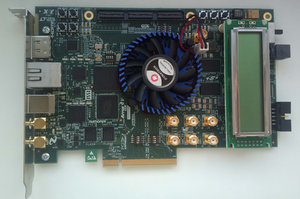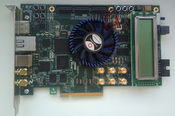Information
- Publication Type: Master Thesis
- Workgroup(s)/Project(s):
- Date: June 2020
- Date (Start): 16. March 2017
- Date (End): 30. June 2020
- TU Wien Library:
- Diploma Examination: 30. June 2020
- Open Access: yes
- First Supervisor:
- Pages: 121
- Keywords: Rendering, FPGA, hardware acceleration, ray tracing, path tracing
Abstract
The synthesis of an image from a scene stored on a computer is called rendering, which is able to deliver photo-realistic results, e.g., by using specific variants of the class of ray tracing algorithms. However, these variants (e.g., path tracing) possess a stochastic characteristic which results in a high computational expense. This is explained by the nature of stochastic algorithms, which use a high number of samples to compute a result—in case of ray tracing, these samples manifest in a high number of rays needed for a complete rendering.One possibility to accelerate ray tracing—no matter if using a stochastic or simpler variants—is the use of customized hardware. FPGRay is such an approach, which combines the use of customized hardware with the software of an off-the-shelf PC to a hybrid solution. This allows increasing the efficiency by specialized hardware and delivers a sustainability in case of changing algorithms at the same time.
The results point towards a possible efficiency gain. Unfortunately, in the scope of this thesis this was not realizable and the specific implementation showed a lower efficiency compared to the software implementation. Nevertheless, the possibility to achieve a higher efficiency with this approach by indicating FPGRay’s potential could be shown.
Additional Files and Images
Weblinks
BibTeX
@mastersthesis{reznicek-2020-fpgaray,
title = "FPGARay: Accelerating Physically Based Rendering Using FPGAs",
author = "Alexander Reznicek",
year = "2020",
abstract = "The synthesis of an image from a scene stored on a computer
is called rendering, which is able to deliver
photo-realistic results, e.g., by using specific variants of
the class of ray tracing algorithms. However, these variants
(e.g., path tracing) possess a stochastic characteristic
which results in a high computational expense. This is
explained by the nature of stochastic algorithms, which use
a high number of samples to compute a result—in case of
ray tracing, these samples manifest in a high number of rays
needed for a complete rendering. One possibility to
accelerate ray tracing—no matter if using a stochastic or
simpler variants—is the use of customized hardware. FPGRay
is such an approach, which combines the use of customized
hardware with the software of an off-the-shelf PC to a
hybrid solution. This allows increasing the efficiency by
specialized hardware and delivers a sustainability in case
of changing algorithms at the same time. The results point
towards a possible efficiency gain. Unfortunately, in the
scope of this thesis this was not realizable and the
specific implementation showed a lower efficiency compared
to the software implementation. Nevertheless, the
possibility to achieve a higher efficiency with this
approach by indicating FPGRay’s potential could be shown.",
month = jun,
pages = "121",
address = "Favoritenstrasse 9-11/E193-02, A-1040 Vienna, Austria",
school = "Research Unit of Computer Graphics, Institute of Visual
Computing and Human-Centered Technology, Faculty of
Informatics, TU Wien",
keywords = "Rendering, FPGA, hardware acceleration, ray tracing, path
tracing",
URL = "https://www.cg.tuwien.ac.at/research/publications/2020/reznicek-2020-fpgaray/",
}

 poster
poster thesis
thesis


